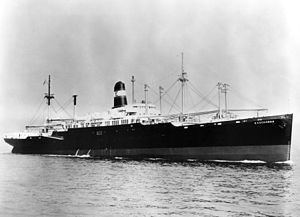Name SS Exochorda Length 144 m Displacement 13.51 million kg Beam 20 m | Christened USS Dauphin (APA-97) Weight 15,130 tons Draft 7.62 m | |
 | ||
Namesake SS Exochorda of the pre-war "4 Aces" Laid down 2 December 1943 (as cargo ship) Launched 10 June 1944 (as USS Dauphin (APA-97)) Sponsored by Mary B. Cooke (as USS Dauphin) Builders Bethlehem Steel, Sparrows Point Shipyard Industrial Complex, Sparrows Point, Maryland | ||
SS Exochorda, a 473-foot, 14,500-ton cargo liner in service with American Export Lines from 1948 to 1959. A member of the line's post-war quartet of ships, "4 Aces", Exochorda sailed regularly from New York on a Mediterranean route. Originally built in 1944 as the military attack transport USS Dauphin (APA-97), the ship was extensively refurbished prior to her service as a passenger-cargo liner. Following her service as a cruise liner, the vessel served as the floating dormitory ship SS Stevens for the students of Stevens Institute of Technology, a technological university, in Hoboken, NJ. At the end of her service life she was scrapped, in 1979.
Contents
Diverted for war service
In 1944 American Export Lines built a new fleet of "4 Aces" ships, planned to replace the earlier, pre-war "4 Aces". However, the ships were requisitioned by the US Navy for service in World War II and converted to Windsor-class attack transport vessels. The vessel that would later become Exochorda served as Dauphin for the US Navy, from 1944 to 1948. Dauphin was awarded one battle star in the assault on and occupation of Okinawa and earned the Navy Occupation Service Medal for landing cargo and troops in Japan. She was present in Tokyo Bay for the Surrender Ceremony of World War II, 2 September 1945.
Following the war, in November 1947, the ships were returned to dry dock at the Hoboken Yard of Bethlehem Steel Corporation for conversion back to passenger cargo ships for American Export Lines. Dauphin became Exochorda of the post-war "4 Aces", taking her new name from her predecessor in the pre-war fleet.
Extensive Refurbishment
Fashioning the modern (1948) cruise liner Exochorda from Dauphin required stripping the vessel to the bare hull and machinery. An entirely new superstructure was built that included passenger staterooms located primarily on promenade and "A" decks.
Noted industrial decorator Henry Dreyfuss, whose many designs included the "Twentieth Century Limited" locomotive (1938) for the New York Central Railroad, and the "500" desk telephone (1949), the Bell System standard for 45 years, designed the interiors. Zalud Marine Corporation executed the design, including joiner work, that included thousands of feet of carpet, specially woven fabrics and an unusual amount of glass.
Exochorda was among the first ships with fully air-conditioned staterooms, many of which were also soundproofed. The ship's glass-enclosed promenade deck featured a built-in swimming pool and play area adjacent to a modern bar and smoking room.
Sea safety standards were unusually high and included modern (1948) smoke detection, fire control and fireproofing.
On the day following her final sea trials, 26 October 1948, the ship was formally delivered to American Export Lines at the company's terminal at Exchange Place, Jersey City, NJ. Delivery had been delayed due to a faulty valve that needed replacement. Exochorda departed on her maiden voyage November 1948.
Artwork
All artwork for the new 4 Aces ships had been selected by interior designer Henry Dreyfuss. Dreyfuss had commissioned artist Miné Okubo to create a mural reflecting the ship's Mediterranean sailing route, to be located in the ship's main foyer. Other notable artwork included white-on-black depictions of life at sea — whimsical "doodles" by artist Saul Steinberg — which added subtle context to Promenade's bar and smoking lounge. While in the dining lounge, passengers were treated to Loren MacIver's mural portrayal of trade and commerce activities along the sailing route. Despite being pictured in promenade's forward lounge in many "4 Aces" print advertisements, sculptress Mitzi Solomon had created only two unique marble carvings that were used on other "4 Aces" vessels.
